Will you love growing sage because it has such a delicious flavor and fragrance or because it’s an almost fail-proof herb? I am definitely all in for easy-to-grow plants and sage fits the bill. But the taste and smell of freshly crushed sage leaves… oh my! In this guide on how to grow sage, we’ll share the step-by-step process that will ensure you find delight in the sage grown in your herb garden.
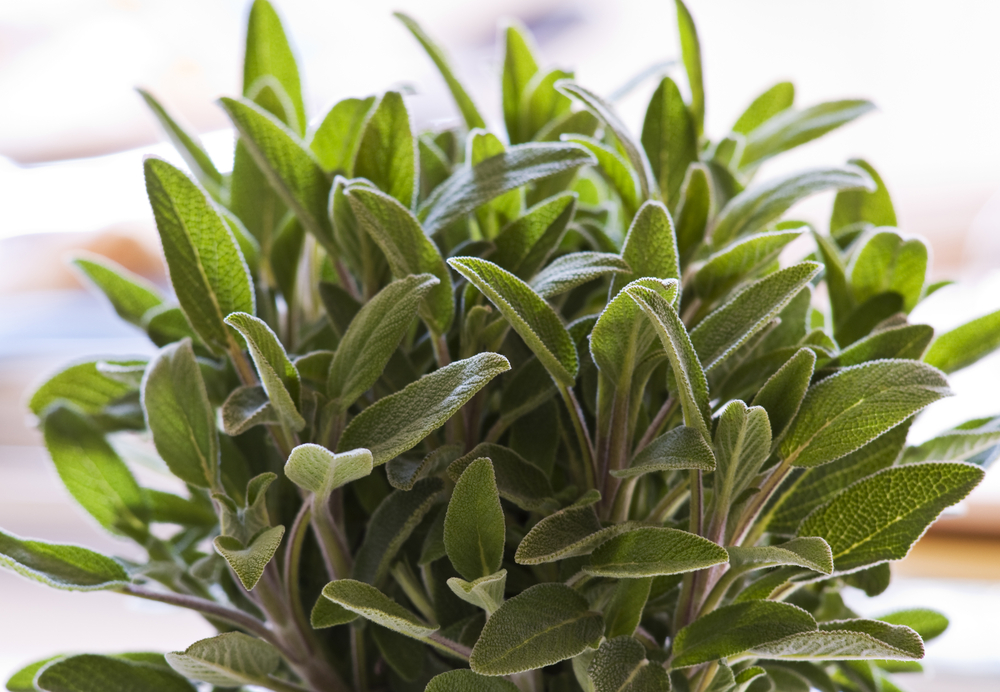
By growing your own sage, you’ll not only have an easy-to-grow herb but also a plant that has many uses and benefits.
- You’ll find sage to be a very low-maintenance plant, thriving in a variety of conditions. Not that I’m proud of it, but my sage has survived a lot of neglect in my garden.
- Growing your own sage means you’ll have quick access to fresh herbs for your culinary creations. Fresh sage has more flavor than dried store-bought versions.
- Sage is a natural pest deterrent. When you grow sage in your garden, it will help keep unwanted insects, like cabbage moths and carrot flies, away from other plants.
- This fragrant herb also has various medicinal properties, traditionally used for anti-inflammatory and antioxidant effects.
- Cultivating sage also adds texture and beauty to your garden, the lovely spikes of purple flowers tower over the grayish-green leaves.
This article may contain affiliate links to products that we mention, if you buy something through one of those links we may earn a small commission at no extra charge to you.
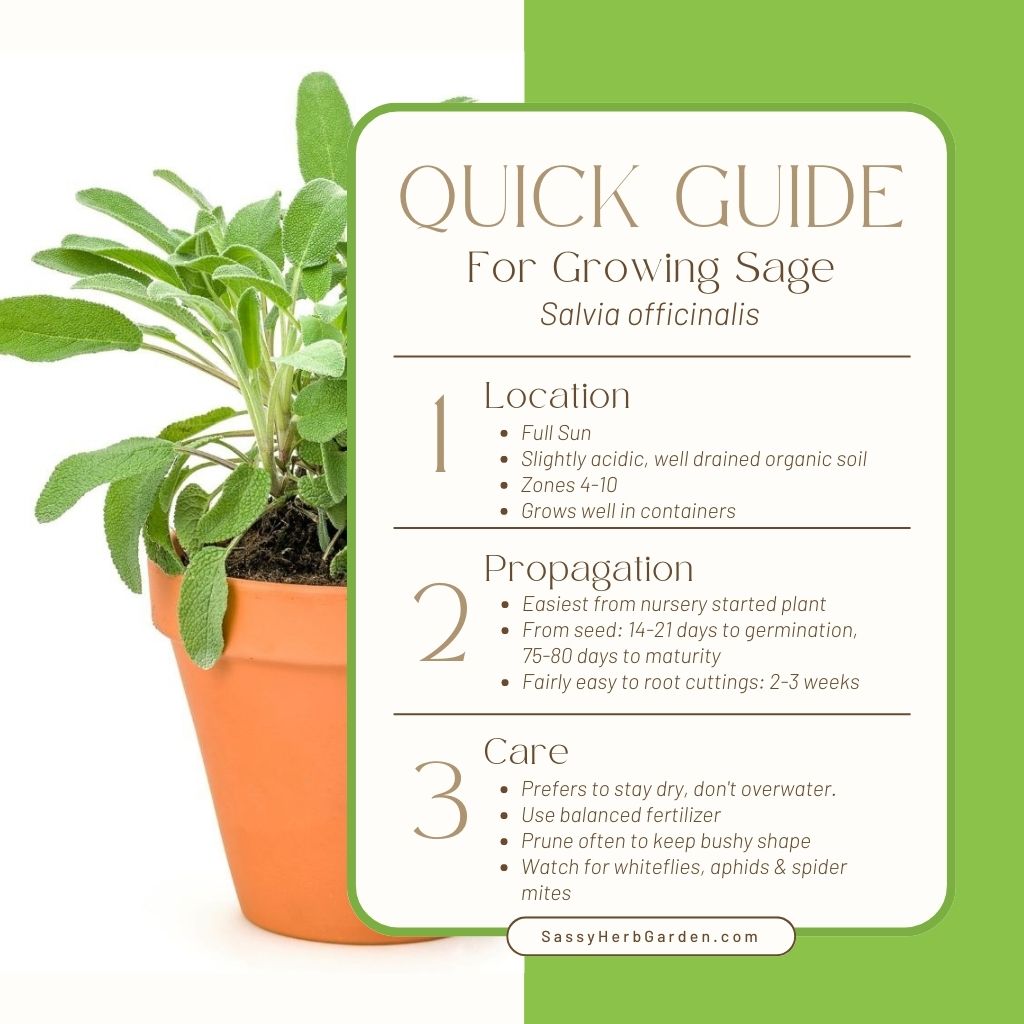
How to Grow Sage: Getting Started
Sage is one of the easiest herbs to grow and I recommend beginning gardeners include this fragrant plant in their herb garden. For sage, you can choose between planting already started plants from your local garden center or getting creative with seeds or cuttings. All three methods of propagating sage have a high success rate.
Selecting Plants Started in a Nursery
In the spring you’ll find sage plants in every garden center and grocery store because it is such a popular herb for home gardeners. Buying a sage plant that is already started is by far the easiest way to begin your herb garden. While seeds are easy to grow, they also have a longer lead time, so picking out a healthy plant from your local store will save you considerable time and effort.
The most important step when selecting a sage plant is to look at the underside of the leaves to make sure no insects have settled in and started to feed. Look for plants that have dark green leaves with no blemishes. Blemishes on the leaves might be a sign that the plant had insects on it previously that have been killed off with pesticides. In this case, eggs might still be present and they are so tiny that you can’t see them. Don’t take a chance and bring that plant into your garden.
Also, don’t give in to the desire to bring a sad-looking sage plant home and nurse it back to health. I know… it’s hard to resist because we all know how good it feels when you succeed at rescuing a sick plant. But the risk of bringing something into your garden that can harm your other sweet herbs is too high.
It’s actually rare when I find infected herb plants in a garden center and it’s so easy to do a quick check before purchasing. So take advantage of the work someone else did! I buy a lot of herbs in our local garden centers because of the time-saving factor.
Growing Sage from Seed
Growing sage from seed is very easy but requires a little patience. That’s because you need to start your seeds about 2 months before you want to plant outside to get a healthy transplant. The reason to start sage from seed is to take advantage of the large number of sage varieties available. Once you start growing sage, you’ll become addicted to the aroma and flavor and want to try out new variations!

Plant sage seeds in quality seed starter soil and place them in a warm location with indirect light. You only want to place the seeds 1/4 inch deep with a fine covering of soil on top. It’s going to take 14-21 days before you see germination and it’s important to keep the soil moist but not wet during this time.
Once the seeds germinate, thin them out to a 4-inch spacing and move to bright light or place them under grow lights. Continue to keep the soil moist but not wet.
Note if you live in a southern zone with a long growing season you can direct sow sage outdoors about two weeks before the last frost when the soil temperature is between 60 and 70°F. It will take 75-80 days for sage to reach maturity so direct planting in northern zones isn’t very practical.
Transplanting Seedlings
Once your sage seedlings have grown large enough (typically after they develop a few sets of true leaves), it’s time to transplant them:
- Gradually expose your seedlings to outdoor conditions by taking them outside for short periods. This process called hardening off, helps them adapt to the outdoor environment.
- Choose a planting location with medium to full sun for optimal growth, as sage thrives in these conditions
- Ensure your garden has well-drained soil, as sage prefers a slightly dry environment.
- Space sage seedlings or transplants about 20 inches apart, and allow for 20 to 24 inches between rows.
Starting Sage from Cuttings
Sage is an herb that can also easily be propagated from cuttings. Cuttings are a great way to share new varieties among friends. Cuttings can be rooted in water or in soil with equal success.
- Take your cuttings from the tender stems, not the older woody parts. A cutting should be about 6 inches long and includes a couple of leaf nodes. When making your cut, consider that you’ll want one leaf node below the surface of soil or water and another set of leaves above the surface. Roots will grow out of the nodes below the surface while the leaves above provide sustenance.
- Remove the lower leaves and insert the cutting into moist soil or into a glass of water. Using a rooting hormone with the soil method is optional when starting sage from cuttings. A rooting hormone will improve your success rate, but sage usually roots easily without it.
- Place your containers of cuttings in a warm location but not in full sun. Too much sunlight will stress the cuttings.
- Keep the potting soil moist but not wet while you wait for the cuttings to root. If you use the water method, make sure you regularly add water to maintain the water line.
- It takes 2-3 weeks for sage to develop roots, and another couple of weeks before the cuttings can be transplanted. Once the roots are over 1 inch long, transplant them to individual pots or plant cells and move to a sunny location. Let them grow for 2-3 more weeks before planting into the ground.
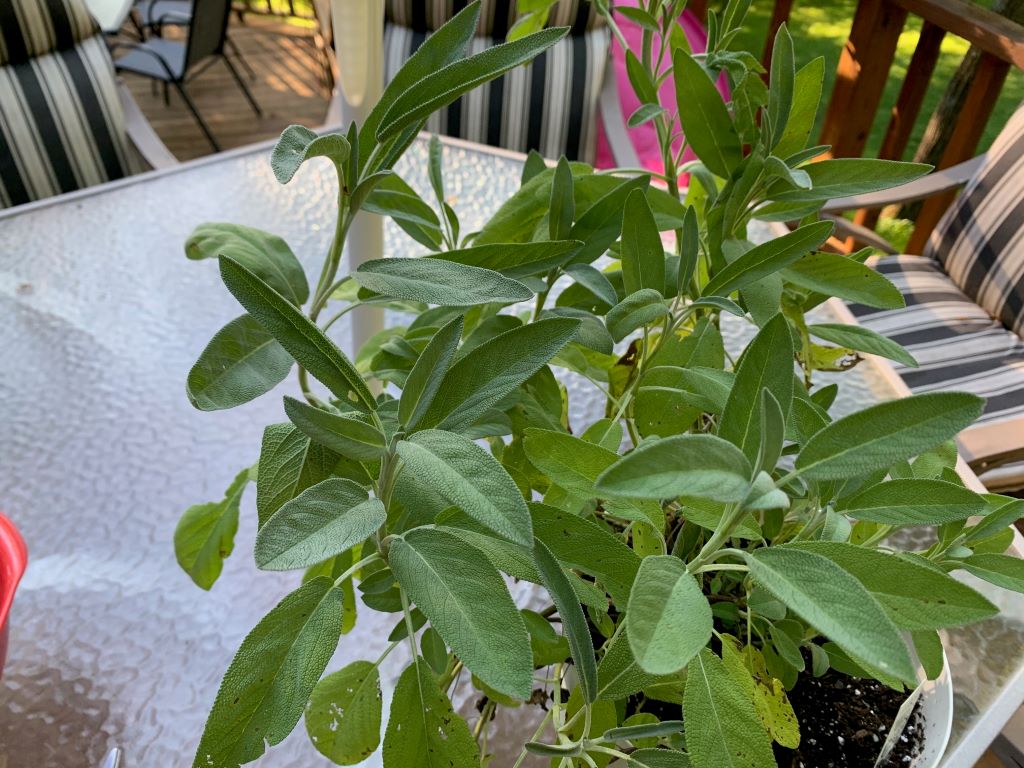
Choosing a Location for Sage in Your Garden
Sage is easy to grow. It is very forgiving of neglect and dry conditions. However, it doesn’t like a wet area.
- Sunlight: Sage is a true sun lover so make sure your garden location has at least 6 hours of direct sunlight per day.
- Soil: Sage prefers slightly acidic soil. It does best in garden soil that has a lot of organic matter mixed in and that drains well so work your ground well before planting.
- Air Movement: Since sage doesn’t like damp locations, it’s important to select a spot with good air movement.
Preparing the Soil
Before planting sage, prepare the soil to ensure healthy growth. Here are a few tips:
- If you don’t know the pH of the soil in your garden, test it. Test kits are inexpensive and easy to use. Before you plant is the best time to add organic lime to raise it or ammonium sulfate to lower the pH. Your target range is between 6.0 and 7.0 pH.
- Add compost or aged manure to the soil to improve the organic composition and drainage.
- Loosen the soil to a depth of 12-18 inches.
- Remove weeds or debris from the area.
By taking time to prepare the soil before planting sage in your garden, you create a healthy environment for your herb garden.
Growing Sage in Pots
Sage thrives in pots equally well as planting in your garden as long as you can provide plenty of sunlight. Sage is perfect for a patio or balcony garden since you can control the size by pruning often.
You also can easily keep potted sage inside. I keep a smaller pot in my kitchen window all winter, ready to pluck to add to meatloaf or my Thanksgiving dressing. And I love just crushing a single leaf to inhale the amazing fragrance on a cold winter day. Note that sage plants will get a little spindly inside unless you have a sunny southern-facing window. For me, that’s ok as I will move that plant outside in the spring, replant it into a bigger pot and watch it grow like crazy over the summer.
Choosing the Best Pot and Potting Soil to Grow Your Sage
While sage would prefer to grow in a larger pot, it needs at least an 8-inch pot to let it spread its roots. You will need good drainage in the pot so the soil doesn’t stay too wet after watering because sage likes the soil to be on the dry side.
A rich organic and lightweight potting soil is best for sage grown in pots. I’ve had really good luck with Miracle Grow’s organic mix.
Caring for Your Growing Sage
Caring for sage plants is relatively easy when following some basic guidelines. Let’s take a look at some essential aspects of sage plant care:
Watering Requirements
Sage plants prefer well-draining soil and do not tolerate excessive moisture. It’s important to avoid overwatering, as this can lead to root rot. Water your sage plant deeply giving your plant a good soaking, then allow the soil to dry out slightly before watering again.
Fertilizing
Sage plants benefit from the nutrients provided by compost. Adding compost to your sage plant’s soil when you prepare it in the spring can help maintain its health and vigor. Avoid using high-nitrogen fertilizers, as they can cause the foliage to become soft and less flavorful. A well-balanced fertilizer like a 10-10-10 is more appropriate for sage. For the garden, I like using a granular organic-based fertilizer which releases into the soil with each watering. And for potted sage, liquid fertilizer is ideal.
Pruning
Regular pruning is important for keeping your sage plant shapely and promoting new growth. That means you should feel free to harvest sage throughout the growing season for all your delightful kitchen creations. As sage plants get older, they tend to become woody and less productive. To prevent this, make sure to prune the plant regularly, cutting back the branching stems to stimulate fresh growth.
Harvesting
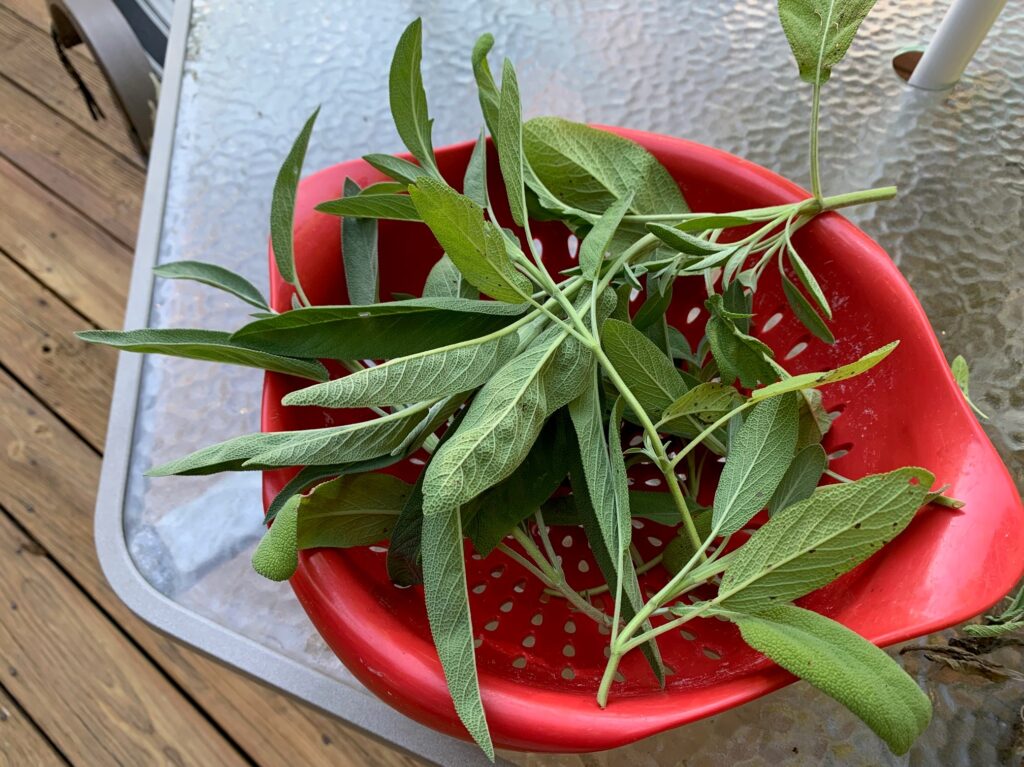
To harvest your sage plant, snip sections of the stem 4-6 inches long, cutting off no more than one-third of the plant at a time. It’s important to leave plenty of healthy growth behind to feed the sage plant. It’s also best to harvest sage leaves before the plant starts to flower, as this is when they have the highest concentration of essential oils.
Common Problems and Solutions When Growing Sage
Overwatering
One of the most common issues when growing sage is overwatering. Sage prefers well-draining, sandy, or loamy soils and requires regular, even watering until established. However, once established, it’s essential to keep the soil on the dry side. Too much water can lead to root rot and other problems.
To avoid overwatering:
- Ensure the soil has proper drainage.
- Water sparingly after establishment.
- Keep an eye on soil moisture levels and adjust watering accordingly.
Common Pests

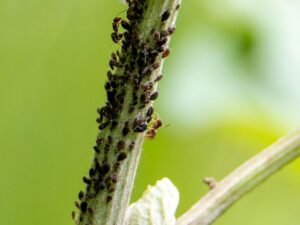

Sage plants can sometimes be affected by pests like aphids, whiteflies, and spider mites. It’s pretty easy to spot these pests on the underside of the tender leaves or on the new shoots of your sage plants. If you notice any bugs on your sage plants, first try removing the insects with a strong spray of water from your hose. However, don’t get too crazy with the force of the water or you will shred the leaves.
If the infestation has gone too far, using an organic insecticidal soap can help remove them. It will take several applications as insecticidal soaps only work on adult bugs, not eggs. So you have to keep up with a spay regime to catch new insects as they hatch.
Preventative measures include:
- Inspecting your plants regularly for pests.
- Keeping the area around your sage plants clean and free of debris.
- Maintaining proper plant spacing to encourage air circulation, which can help prevent pest infestations.
Disease Control
Diseases in sage are rare if grown in an area with good air circulation. Your best defense is to:
- Provide optimal growth conditions, such as proper soil, watering, and sunlight.
- Remove any diseased or dead plant material to prevent the spread of infection.
- Provide space between your sage plants so air freely moves around them.
However, if you do see signs of a fungal infection, first dry out the area where your sage is growing. Then you can apply an organic fungicide. Some common symptoms to look for are rusty spots, yellowed foliage, and white bumps on the underside of leaves.
Preserving the Sage You’ve Grown
Growing sage is fun because you are sure to have a bountiful harvest. To enjoy the benefits of your sage plant long after the growing season, it’s essential to preserve it properly. The most common method to preserve sage is to dry it and store it for future use. However, you can also freeze sage. Here are a few tips for preserving your sage.
Refrigerating Fresh Sage
Of course, using fresh sage leaves is the perfect way to get the most flavor in your culinary endeavors. The stems can be stored in the refrigerator for 2 to 3 days. Simply wrap the leaves in a paper towel and place them in a plastic bag.
Drying Your Sage
Drying sage is a popular method to preserve this wonderful herb since it concentrates the flavors and allows you to store the herb for an extended period. While the best way to dry sage and retain the flavor is to air dry it, you can also dry sage in a dehydrator, in the oven, use your microwave for small batches or even dry it in an air fryer.
To air-dry sage, it’s important to have plenty of air circulation and a dry, low-light location. You can hang in bundles which I’m sure you’ve seen in many country magazines or spread out on a drying screen. Air drying takes a little bit of space and time which is why gardeners often prefer one of the other drying methods where they can be finished in a few hours.
Once your sage is dry, crumble the leaves and discard any stems. Then store in airtight containers. Dried sage will hold its flavor well for 4-6 months.
We have a detailed guide to drying sage where we walk through all the drying methods. It has tips to help you decide the best method that fits your needs.
Freezing Your Sage
Freezing is another excellent method to maintain the flavor and aroma of sage leaves. There are three primary ways to freeze sage:
- Wash and strip the leaves from the stem, pat them dry with paper towels, and lay them on a tray. Place the tray in the freezer until the leaves are frozen, then transfer them to a freezer bag for storage.
- Finely chop the sage and place it in ice cube trays. Add water or olive oil to fill the trays and freeze them. Once frozen, transfer the sage cubes to a freezer bag.
- Form a paste by blending sage leaves with a small amount of water or oil. Store the paste in an airtight container and freeze it.
With these methods, you can preserve your sage and enjoy its distinct flavor in your cooking throughout the year.
Other Considerations When Growing Sage
Selecting the Best Sage Varieties to Grow
When it comes to growing sage, there are dozens of varieties to choose from. You can really have fun exploring all the different varieties and many herb gardeners enjoy exchanging cuttings of sage to expand their herb garden. For a beginning gardener, I suggest starting with one of these three popular types: Common Sage, Pineapple Sage, and Purple Sage.
Common Sage
Also known as garden sage or Salvia officinalis, Common Sage is a popular and versatile herb that works well in many dishes. This variety is known for its grayish-green leaves and strong, earthy flavor.
Pineapple Sage
Pineapple Sage (Salvia elegans) is a unique variety of sage with a fruity aroma resembling pineapples. It has bright red flowers that attract hummingbirds and butterflies, making it a beautiful addition to any garden.
Purple Sage
Purple Sage (Salvia officinalis ‘Purpurascens’) is a striking variety with beautiful purple-tinged leaves. It has a similar flavor to Common Sage but with a milder and sweeter taste.
Companion Planting With Sage
Sage plays well with many other herbs and vegetables making it easy to find a spot to grow in your garden. Here are a few plants that are great companions for sage.
- Rosemary: Sage and rosemary are both members of the mint family and share similar growth requirements. They have compatible watering and sunlight needs and can provide a visually appealing and aromatic herb garden. Growing them together also helps deter certain pests, such as cabbage moths and carrot flies.
- Thyme: Thyme and sage are excellent companions as they have similar soil and watering preferences. Both herbs also release natural oils that repel certain pests like cabbage loopers and whiteflies. Planting them together can help create a more robust herb garden and provide additional culinary options.
- Lavender: Sage and lavender make a beautiful and fragrant combination. Lavender’s strong scent can help repel pests like mosquitoes, moths, and aphids. Additionally, both plants prefer well-draining soil and full sunlight, making them compatible growing companions.
- Cabbage and Brassicas: Sage is known to deter cabbage moths and cabbage loopers, which are common pests for cabbage and other Brassica family plants. By planting sage near cabbage, broccoli, kale, or other Brassicas, you can help protect them from these pests naturally.
- Carrots: Sage can also be beneficial when grown alongside carrots. It repels carrot flies, which are notorious for damaging carrot crops. Planting sage near carrot rows can help keep these pests at bay and improve carrot yields.
- Beans: Sage can enhance the flavor of beans and other legumes when grown in proximity. Additionally, it acts as a natural deterrent for pests like bean beetles and cabbage loopers that commonly affect legume plants.
- Tomatoes: Sage’s aromatic foliage can help repel pests like whiteflies and hornworms, which are known to affect tomato plants. By planting sage near tomatoes, you can provide a natural defense against these pests and potentially improve tomato yields.
Avoid planting sage in the same space as other plants that have a higher watering requirement, such as basil and chives. You’ll find only one can win when it comes to providing too much or too little water.
Sage’s flowers attract pollinating insects like butterflies and moths. This makes it the perfect plant to be included in a vegetable garden.
Frequently Asked Questions about How to Grow Sage
Sage thrives in well-drained soil with full sun exposure. It prefers a pH level between 6.0 and 7.0.
Sage seeds usually take about 14 to 21 days to germinate. The plant can reach maturity in approximately 70 to 80 days.
Yes, sage can be grown indoors if provided with sufficient sunlight or artificial grow lights. Ensure proper air circulation and avoid overwatering.
Yes, sage is one of the easiest herbs to grow and is perfect for beginning gardeners.
Sage prefers a sunny location. It will grow in light shade but will be a little spindly.
Sage is an excellent houseplant as long as you have a very sunny location. It can withstand a lot of different environments making it ideal for growing inside.

